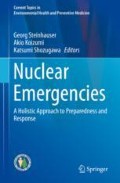Abstract
Competent and independent (science) journalism is needed not only, but especially in times of crisis. The accident at the Fukushima Daiichi nuclear power plant in March 2011 can be viewed as an example of the role and responsibility the professional media has to take on in the age of the digital revolution.
A limited empirical evaluation of German news media coverage during the nuclear emergency response serves as a case study here. By reflecting on decision-making processes at ZEIT ONLINE, being one of the largest platforms for online journalism in the German-speaking countries, five paradoxes and implications are discussed.
Today the ability to report immediately includes the obligation to do so, with all its shortcomings. Journalists have to precisely tell users, readers, and viewers what they know and what they do not know as well as constantly correct mistakes and clarify circumstances.
Additionally, as debunking misinformation can easily strengthen the belief in false facts, accurate and transparent reporting without speculation is essential.
Science and facts can help people make informed decisions when presented in a way that embraces unknowns and explains behavioral patterns. But science cannot only prove a point but also be used to manipulate truth. Therefore, journalists and scientists need to work together—respecting a professional distance—to value their shared asset of credibility.
To report facts truthfully and to report the truth about a fact is a process that has to be refined and adapted constantly.
Access this chapter
Tax calculation will be finalised at checkout
Purchases are for personal use only
References
The Commission on Freedom of the Press. A free and responsible press. The University Of Chicago Press, Chicago. 1947, p. 22. The Internet Archive. https://archive.org/details/freeandresponsib029216mbp/page/n37. Accessed 30 Aug 2018.
iq media marketing gmbh. https://www.iqm.de/digital/marken/zeit-online/. Accessed 11 June 2019.
Wegner J. Die fünf Paradoxien der Livemedien und der Mythos des Oknos. ZEIT ONLINE. 2016. https://www.zeit.de/gesellschaft/2016-07/online-journalismus-medien-amoklauf-muenchen. Accessed 21 Aug 2018.
Kovach B, Rosenstiel T. The elements of journalism: what newspeople should know and the public should expect. New York: Random House; 2014.
Stockrahm S. Von Super-GAU bis glimpflich ist alles möglich. ZEIT ONLINE. 2011. https://www.zeit.de/wissen/umwelt/2011-03/fukushima-szenarien-japan. Accessed 20 Sept 2018.
Stockrahm S. Japan drückt sich um eine Perspektive nach Fukushima. ZEIT ONLINE. 2012. https://www.zeit.de/wissen/umwelt/2012-07/fukushima-abschlussbericht-zukunft-kommentar. Accessed 20 Sept 2018.
Peter Clark R. The pyramid of journalism competence: what journalists need to know. Pointer. 2014. https://www.poynter.org/news/pyramid-journalism-competence-what-journalists-need-know. Accessed 28 Sept 2018.
World Health Organization. Health risk assessment from the nuclear accident after the 2011 Great East Japan earthquake and tsunami, based on a preliminary dose estimation. Geneva: WHO; 2013.
United Nations Scientific Committee on the Effects of Atomic Radiation. Levels and effects of radiation exposure due to the nuclear accident after the 2011 great east-Japan earthquake and tsunami. Volume I scientific annex A. New York: United Nations; 2014.
Stockrahm S. Die Strahlung ist nicht das Schlimmste. ZEIT ONLINE. 2013. https://www.zeit.de/wissen/umwelt/2013-02/fukushima-langzeitfolgen-radioaktivitaet-psyche-tschernobyl. Accessed 28 Sept 2018.
Pennycook G, Cannon T, Rand D. Prior exposure increases perceived accuracy of fake news. J Exp Psychol Gen. 2018. https://doi.org/10.2139/ssrn.2958246.
Chan M, Jones C, Jamieson K, Albarracín D. Debunking: a meta-analysis of the psychological efficacy of messages countering misinformation. Psychol Sci. 2017;28(11):1531–46. https://doi.org/10.1177/0956797617714579.
World Health Organization. Chernobyl at 25th anniversary – frequently asked questions – April 2011. WHO, Geneva. 2011. http://www.who.int/ionizing_radiation/chernobyl/20110423_FAQs_Chernobyl.pdf. Accessed 28 Sept 2018.
Deutscher Bundestag. Atomausstieg und Energiewende als “Herkulesaufgabe”. 2011. https://www.bundestag.de/dokumente/textarchiv/2011/34716466_kw23_de_atomgesetz/205630. Accessed 28 Sept 2018.
Deutscher Bundestag. Die Beschlüsse des Bundestages am 30. Juni und 1. Juli. 2011. https://www.bundestag.de/dokumente/textarchiv/2011/34915890_kw26_angenommen_abgelehnt/205788. Accessed 28 Sept 2018.
Statistisches Bundesamt. Pressemitteilung Nr. 063 0,9 % weniger Verkehrstote im Jahr 2017. 2018. https://www.destatis.de/DE/PresseService/Presse/Pressemitteilungen/2018/02/PD18_063_46241.html. Accessed 28 Sept 2018.
Maeda M, Oe M. Mental health consequences and social issues after the Fukushima disaster. Asia Pacific Journal of Public Health. 2017;29:36S. https://doi.org/10.1177/1010539516689695.
Author information
Authors and Affiliations
Corresponding author
Editor information
Editors and Affiliations
Additional information
Sven Stockrahm is a science journalist, editor, podcaster and staff writer for the German news site ZEIT ONLINE. Since 2018, he is the deputy head of the science, technology, and digital news section. His reporting on the Fukushima Daiichi nuclear accident has been recognized as outstanding achievement by the jury of the German Axel-Springer-Prize in 2012.
Rights and permissions
Copyright information
© 2019 Springer Nature Singapore Pte Ltd.
About this chapter
Cite this chapter
Stockrahm, S. (2019). “Fukushima Live”: About the Role and Responsibility of the Media. In: Steinhauser, G., Koizumi, A., Shozugawa, K. (eds) Nuclear Emergencies. Current Topics in Environmental Health and Preventive Medicine. Springer, Singapore. https://doi.org/10.1007/978-981-13-8327-4_10
Download citation
DOI: https://doi.org/10.1007/978-981-13-8327-4_10
Published:
Publisher Name: Springer, Singapore
Print ISBN: 978-981-13-8326-7
Online ISBN: 978-981-13-8327-4
eBook Packages: MedicineMedicine (R0)

